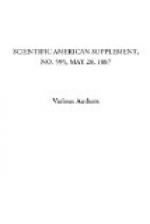We must first consider the state in which the supposed molecules exist in the air, before making progress.
The present science teaches that the diameter of the supposed molecules of the air is about 1/250000000 of an inch (Tait); that the distance between the molecules is about 8/100000 of an inch; that the velocity of the molecules is about 1,512 feet a second at 0 deg.C., in its free path; that the number of molecules in a cubic inch at 0 deg.C. is 3,505,519,800,000,000,000 or 35 followed by 17 ciphers (35)^{17}; and that the number of collisions per second that the molecules make is, according to Boltzmann, for hydrogen, 17,700,000,000, that is to say, a hydrogen molecule in one second has its course wholly changed over seventeen billion times. Assuming seventeen billion or million to be right for the supposed air molecules, we have a very interesting problem to consider.
The wave theory of sound requires, if we expect to hear sound by means of a C^{3} fork of 256 vibrations, that the molecules of the air composing the sound wave must not be interfered with in such a way as to prevent them from traveling a distance of at least 1/50 to 1/1000000 of an inch forward and back in the 1/256 of a second. The problem we have to explain is, how a molecule traveling at the rate of 1,512 feet a second through a mean path of 8/100000 of an inch, and colliding seventeen billion or million times a second, can, by the vibration of the C^{3} fork, be made to vibrate so as to have a pendulous motion for 1/256 of a second and vibrate through a distance of 1/50 to the 1/1000000 of an inch without being changed or mar its harmonic motion.
It is claimed that the range of sound lies between 16 vibrations and 30,000 (about); in such extreme cases the molecules would require 1/16 and 1/30000 of a second to perform the same journey.
It must not be forgotten that a mass moving through a given distance has the power of doing work, and the amount of energy it will exercise will depend on its velocity. Now, a molecule of oxygen or nitrogen, according to modern science, is a mass 1/250000000 of an inch in diameter, and an oxygen molecule has been calculated to weigh 0.0000000054044 ounce. Taking this weight traveling with a velocity of 1,512 feet a second through an average distance of 8/100000 of an inch, the battering power or momentum it would have can be shown to be in round numbers capable of moving 1/200000 of an ounce.
Now, when the C^{3} tuning fork has been vibrating for some time, but still sounding audibly, Prof. Carter determined that its amplitude of stroke was only the 1/17000 of an inch, or its velocity of motion was at the rate of 1/33 of an inch in one second, or one inch in 33 seconds (over half a minute), or less than one foot in one hour.
Assuming one prong to weigh two ounces, we have a two-ounce mass moving 1/17000 of an inch with a velocity of 1/33 of an inch in one second. The prong, then, has a momentum or can exercise an amount of energy equivalent to 1/200 of an ounce, or can overcome the momentum of 1,000 molecules.




